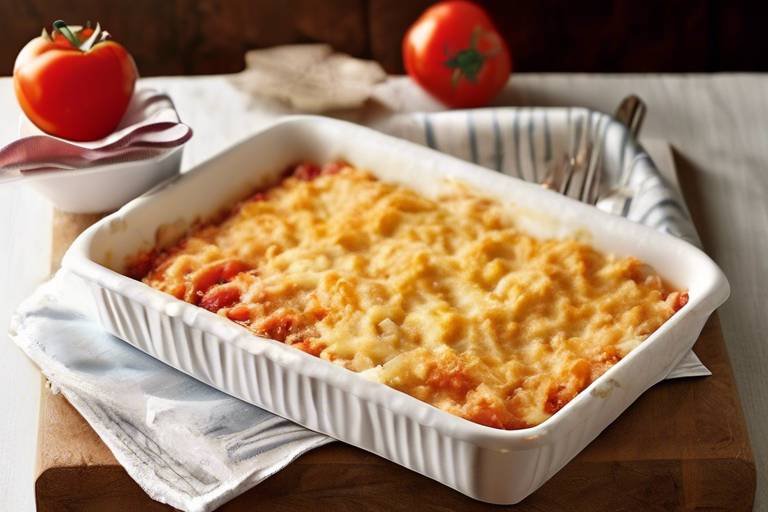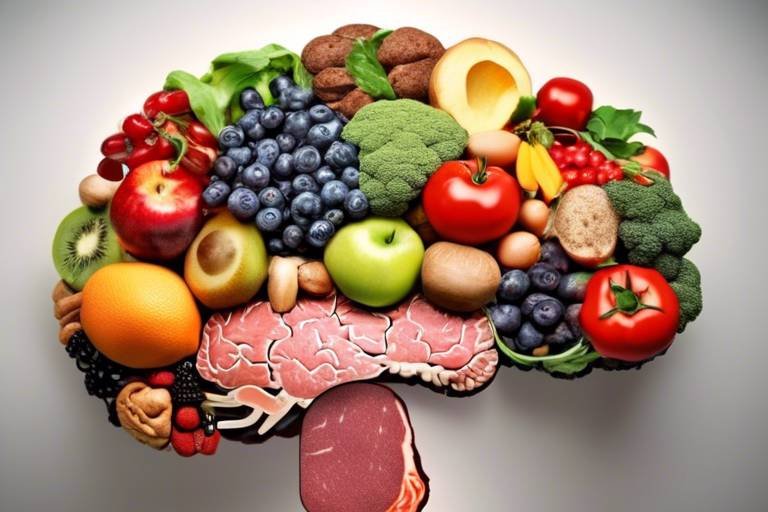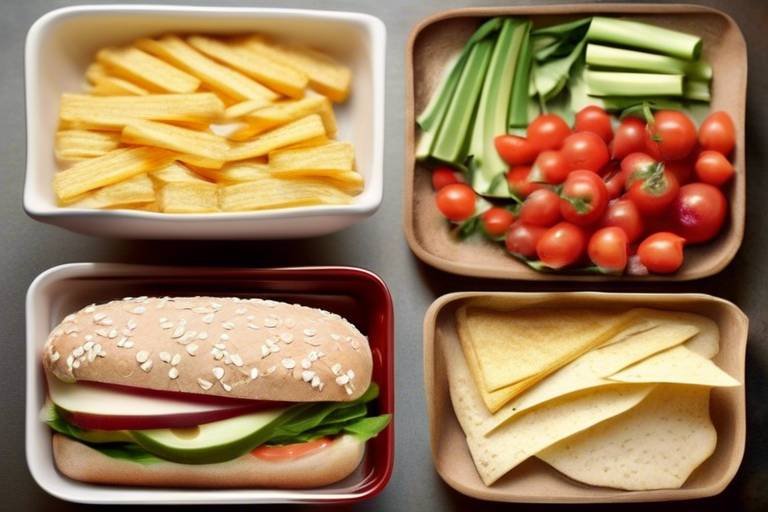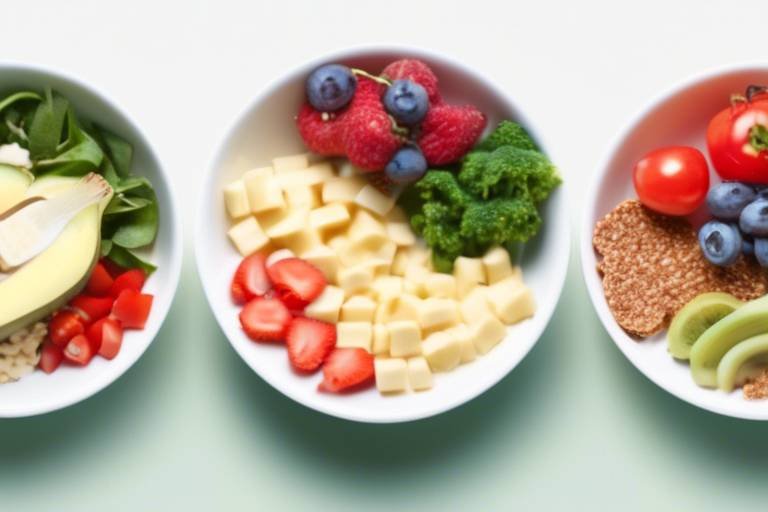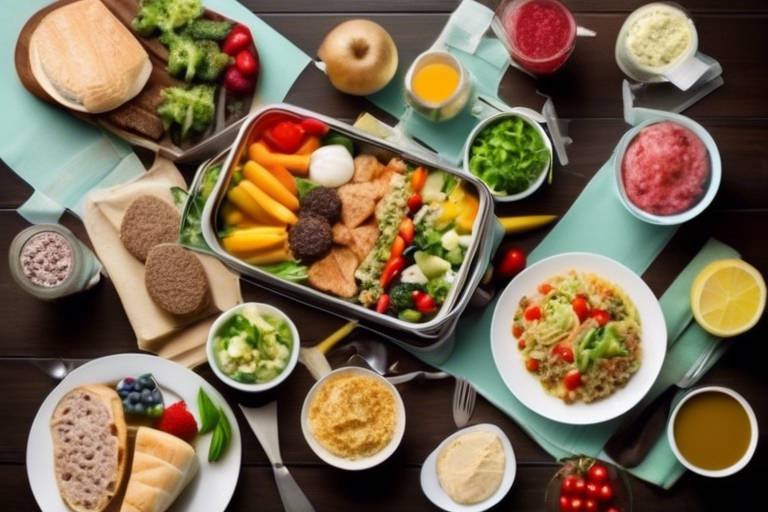Creative Ways to Sneak Veggies into Your Child's Food
Every parent knows the struggle of getting their children to eat vegetables. It can feel like trying to convince a cat to take a bath—nearly impossible! But fear not, there are creative ways to sneak those nutritious veggies into your child's meals without them even noticing. This article explores innovative and fun methods to incorporate vegetables into children's meals, ensuring they receive essential nutrients while enjoying their food without fuss.
Vegetables are like the superheroes of the food world. Packed with vitamins, minerals, and fiber, they play a crucial role in your child's growth and development. Think of them as the building blocks for strong bones, healthy skin, and a robust immune system. Without these vibrant foods, children may miss out on essential nutrients that help them thrive. The key is to make veggies not just palatable but also exciting. When you get creative with how you serve them, you can turn mealtime into an adventure rather than a battle.
One of the best ways to incorporate vegetables into your child's diet is through creative cooking techniques. It’s all about transforming those greens into something that looks and tastes amazing! By using different methods, you can enhance the appeal of vegetables, making them more enjoyable for kids. Let’s dive into some fun ideas that can turn your kitchen into a veggie wonderland.
Blending veggies into smoothies is a delicious way to hide them. Imagine a bright green smoothie that tastes like a tropical vacation! This approach offers a nutrient-rich drink that children will love without realizing they're consuming vegetables. You can create a smoothie that’s not only tasty but also packed with goodness. Just toss in some spinach or kale with their favorite fruits, and voilà! You’ve got yourself a health-boosting drink that’s as fun to make as it is to drink.
Selecting the right fruits and vegetables that pair well together can create a tasty smoothie. Here are some combinations that work wonders:
- Spinach + Banana + Pineapple
- Kale + Mango + Coconut Milk
- Carrot + Orange + Ginger
These combinations not only mask the vegetable flavors but also ensure your child gets a variety of nutrients. Experimenting with different ingredients can be a fun activity for both you and your little ones!
Adjusting the texture and consistency of smoothies can make them more appealing. Kids often love creamy textures, so adding yogurt or avocado can enhance that experience. A thick, luscious smoothie can feel like a treat rather than a chore. You can also freeze fruits beforehand for a refreshing slushy effect. The goal is to create a drink that feels indulgent, making it easier for kids to gulp down those hidden veggies.
Adding vegetables to sauces is another effective way to sneak them into meals. Think about it—who doesn’t love a good pasta sauce? By blending or finely chopping vegetables like carrots, zucchini, or bell peppers and stirring them into sauces, you can enhance the flavor while boosting nutritional value. Kids will be too busy enjoying their spaghetti to notice the extra veggies mixed in!
Once you’ve cooked up those hidden veggies, it’s time to think about how they look on the plate. Presentation is key when it comes to enticing children to try new foods. A colorful plate can be the difference between a clean plate and a dinner-time standoff. Here are some fun ideas to make those veggies pop!
Using vibrant colors in plating can attract children's attention. Kids are naturally drawn to bright colors, so why not take advantage of that? Arrange vegetables in fun shapes or create a rainbow effect on the plate. For instance, you could create a smiley face with cherry tomatoes, cucumber slices, and a sprinkle of cheese. Not only does it look appealing, but it also makes mealtime a playful experience!
Making meals interactive can engage children in the eating process. Think of ideas like veggie skewers or DIY taco bars that include various vegetables. Letting kids build their own meals can make them more excited about trying new ingredients. For example, set up a taco night with bowls of shredded lettuce, diced tomatoes, and colorful peppers. When kids get to choose what goes on their plate, they feel more in control and are often more willing to try new things.
Q: How can I get my child to eat more vegetables?
A: Start by incorporating veggies into dishes they already love, like smoothies or sauces. Make it fun with colorful presentations and interactive meals.
Q: What are some easy vegetables to sneak into meals?
A: Spinach, carrots, and zucchini are great options! They blend well into smoothies and sauces without altering the taste too much.
Q: Can I use frozen vegetables?
A: Absolutely! Frozen vegetables are just as nutritious and can be a convenient option for busy parents.
In conclusion, sneaking veggies into your child's food doesn't have to be a daunting task. With a bit of creativity and some fun techniques, you can ensure your kids are getting the nutrients they need while enjoying their meals. So roll up your sleeves, get cooking, and watch your little ones devour those hidden greens!

Understanding the Importance of Vegetables
When it comes to our children's health, vegetables are a powerhouse of essential nutrients that play a pivotal role in their growth and development. Imagine your child's body as a high-performance engine; without the right fuel, it simply cannot run efficiently. Vegetables are packed with vitamins, minerals, and fiber that not only support physical growth but also enhance cognitive function, boost immunity, and promote overall well-being.
So, why are vegetables so crucial for our little ones? Let's break it down:
- Vitamins and Minerals: Vegetables are rich in vitamins A, C, K, and several B vitamins, as well as vital minerals like potassium and magnesium. These nutrients help in everything from bone health to vision and blood pressure regulation.
- Fiber: A diet high in fiber from vegetables helps in maintaining a healthy digestive system. It can prevent constipation and promote a feeling of fullness, which is especially important as kids grow and their appetites fluctuate.
- Antioxidants: Many vegetables are loaded with antioxidants that combat oxidative stress and inflammation in the body. This means fewer sick days and more energy for play!
- Healthy Habits: Introducing vegetables early on can instill a lifelong habit of healthy eating. When kids are accustomed to seeing veggies on their plates, they're more likely to choose them as snacks and in meals as they grow older.
Incorporating a variety of vegetables into your child's diet is not just about meeting daily nutritional requirements; it's about setting them up for a lifetime of health. Think of it as building a strong foundation for a house. If the base is weak, everything built on top is at risk. Therefore, ensuring that your child receives a colorful array of vegetables daily can significantly contribute to their physical and mental development.
Moreover, the benefits of vegetables extend beyond just nutrition. Engaging children in the process of selecting and preparing vegetables can make them more inclined to eat them. When kids are involved, they feel a sense of ownership over their meals, which can lead to a more adventurous palate. Getting them to help wash, chop, or arrange veggies can turn a mundane task into a fun family activity!
In conclusion, the importance of vegetables in a child's diet cannot be overstated. They are essential for growth, health, and the establishment of healthy eating habits. So, let’s get creative and find ways to sneak those veggies into meals without the fuss. After all, a happy child is a healthy child!

Creative Cooking Techniques
When it comes to getting kids to eat their vegetables, creativity in the kitchen can be a game-changer. Instead of forcing them to eat a side of steamed broccoli, why not transform those veggies into something exciting? By using , you can enhance the appeal of vegetables and make them a delightful part of your child's meals. Think of it as turning the ordinary into the extraordinary, where every bite is an adventure!
One of the most effective methods is to blend vegetables into smoothies. Imagine a vibrant green smoothie that looks like a treat but is packed with nutrition. Kids often love the sweetness of fruits, which can easily mask the taste of less popular veggies. You can use ingredients like spinach, kale, or even carrots, combined with fruits like bananas, strawberries, or mangoes. The key is to find that perfect balance of flavors that makes the smoothie not just nutritious, but also delicious!
Blending veggies into smoothies is a delicious way to hide them. This approach offers a nutrient-rich drink that children will love without realizing they're consuming vegetables. The beauty of smoothies lies in their versatility. You can throw in a handful of spinach, a scoop of avocado, or even some zucchini, and with the right fruits, they’ll never know!
Selecting the right fruits and vegetables that pair well together can create a tasty smoothie. For example, pairing spinach with bananas and a splash of orange juice can create a refreshing drink that masks the taste of greens. Similarly, carrots blended with pineapple and coconut water can yield a tropical treat. Here’s a quick reference table to help you choose the best combinations:
| Vegetable | Best Fruit Pairings |
|---|---|
| Spinach | Banana, Mango |
| Carrot | Pineapple, Apple |
| Kale | Strawberry, Peach |
| Zucchini | Blueberry, Raspberry |
Adjusting the texture and consistency of smoothies can make them even more appealing. A creamy, thick smoothie can feel like a treat, while a thinner consistency might remind kids of juice. You can achieve this by adding ingredients like yogurt or a banana for creaminess, or even a bit of avocado for healthy fats. Experimenting with different textures can turn a simple drink into a fun experience, making your kids eager to gulp it down!
Another fantastic technique is to incorporate vegetables into sauces. Imagine a pasta sauce that not only tastes amazing but is also loaded with hidden nutrients. By finely chopping or pureeing vegetables such as bell peppers, zucchini, or carrots, you can blend them right into marinara or cheese sauces. Kids will be too busy enjoying their spaghetti to notice the extra veggies!
Moreover, roasting vegetables can bring out their natural sweetness, making them more palatable. When you toss veggies like sweet potatoes, carrots, or bell peppers with a bit of olive oil and some herbs, then roast them in the oven, they caramelize beautifully. The result? A delicious side dish that even the pickiest eaters might love. Plus, the vibrant colors of roasted vegetables can be visually appealing, making kids more likely to try them!
In summary, getting creative with cooking techniques can turn the task of sneaking veggies into a fun culinary adventure. By blending, incorporating into sauces, or roasting, you can enhance the flavor and appeal of vegetables, making them a beloved part of your child's diet without any fuss!

Blending for Smoothies
Blending veggies into smoothies is not just a clever trick; it's a delicious way to sneak in those essential nutrients your child needs! Imagine a vibrant, colorful drink that looks like a treat but is packed with the goodness of vegetables. Smoothies can be a game changer for picky eaters who turn their noses up at a plate of broccoli or spinach. By blending veggies with fruits, you create a sweet, refreshing drink that masks the sometimes bitter taste of greens, making it a win-win for both parents and kids.
When crafting the perfect smoothie, it's all about balance and flavor. You want to choose fruits that are naturally sweet, such as bananas, strawberries, or mangoes, which can easily overshadow the flavor of the vegetables. For instance, a banana and spinach smoothie can be incredibly tasty, and your child might never suspect that there's a leafy green hiding in there! Additionally, adding a splash of yogurt or a drizzle of honey can enhance the flavor even more, creating a creamy texture that kids love.
To make the process even smoother, consider the texture and consistency of your smoothie. A thick, creamy smoothie can be more appealing than a watery one. You can achieve this by using frozen fruits, which not only chill the drink but also add a thick consistency. If you find that the smoothie is too thick, simply add a bit of juice or milk to reach the desired texture. Here’s a quick tip: using a good-quality blender can make all the difference in achieving that smooth, silky finish that kids will enjoy.
Here’s a quick look at some of the best fruit and veggie combinations for smoothies:
| Fruit | Vegetable | Flavor Profile |
|---|---|---|
| Banana | Spinach | Sweet and Creamy |
| Mango | Carrot | Tropical and Earthy |
| Strawberry | Kale | Fruity and Slightly Bitter |
| Pineapple | Cucumber | Refreshing and Sweet |
Incorporating vegetables into smoothies is a fantastic way to ensure that your child receives their daily dose of vitamins and minerals without even realizing it. So, the next time you're whipping up a smoothie, remember to experiment with different combinations and textures. You might just find that your child loves their greens more than they thought!
Q: Can I use frozen vegetables in smoothies?
A: Absolutely! Frozen vegetables can add a nice chill and thickness to your smoothies. Just make sure to blend them well to achieve a smooth consistency.
Q: What if my child can taste the vegetables?
A: If your child is sensitive to the taste of vegetables, try using stronger flavored fruits or adding extras like yogurt, nut butter, or a splash of vanilla extract to mask the taste.
Q: How can I get my child involved in making smoothies?
A: Let them choose their favorite fruits and vegetables! You can set up a smoothie bar with various ingredients and let them create their own concoctions. This not only makes it fun but also encourages them to try new things.

Choosing the Right Ingredients
When it comes to sneaking veggies into smoothies, the secret often lies in . You want to create a delightful blend that not only masks the taste of vegetables but also excites your child's palate. Think of it like crafting a masterpiece; each ingredient plays a vital role in the overall flavor and texture of the final product. So, what should you include in your smoothie concoction?
First and foremost, consider the fruits you choose. Fruits like bananas, strawberries, and mangoes are excellent options. They are naturally sweet and can easily overpower the more subtle flavors of greens like spinach or kale. For instance, a ripe banana not only adds sweetness but also contributes to a creamy texture, making your smoothie irresistibly smooth.
Next, let’s talk about vegetables. While you might think that all veggies are created equal, some work better in smoothies than others. Spinach is a top contender because it has a mild flavor that blends seamlessly with fruits. Carrots, on the other hand, add a lovely sweetness but may require a bit of adjustment in terms of texture. Experimenting with frozen vegetables can also be a game changer. Frozen cauliflower, for example, can give your smoothie a thick, creamy consistency without altering the taste significantly.
Another crucial aspect is the liquid base. The choice of liquid can greatly influence the flavor profile of your smoothie. While water is a healthy option, consider using almond milk, coconut water, or even fruit juice for added flavor. These alternatives not only enhance the taste but can also provide additional nutrients. Just remember to keep an eye on the sugar content if you're using juice.
Lastly, don't shy away from adding a touch of healthy fats or protein. Ingredients like nut butters, avocado, or Greek yogurt can elevate the nutritional value of your smoothie while making it more satisfying. A tablespoon of peanut butter can turn an ordinary smoothie into a creamy delight that your child will love, while also providing essential nutrients.
In summary, the right combination is key to crafting a smoothie that your child will enjoy. By blending sweet fruits with mild vegetables, choosing a flavorful liquid base, and adding a bit of healthy fat or protein, you can create a delicious drink that sneaks in the nutrients they need without any fuss. Remember, it’s all about balance and creativity!
- What vegetables work best in smoothies? Spinach, kale, and frozen cauliflower are great options due to their mild flavors.
- Can I use frozen fruits and vegetables? Absolutely! Frozen produce can enhance texture and make your smoothie creamier.
- How can I make my smoothie more appealing to my child? Use vibrant colors, fun straws, and let them help in the preparation!

Texture and Consistency
When it comes to sneaking veggies into smoothies, play a crucial role in making the drink appealing to kids. After all, if a smoothie is too chunky or watery, children might turn their noses up at it before even taking a sip! The key is to find that perfect balance that creates a creamy, delicious drink that feels indulgent, rather than a health chore. Think of it like crafting a perfect milkshake; it should be smooth and enjoyable, not a battle to get through.
One effective way to achieve that delightful texture is by using a base of frozen fruits. Bananas, for instance, not only add natural sweetness but also contribute to a thick, creamy consistency when blended. Combining bananas with a handful of spinach can create a vibrant green smoothie that kids will love, especially when they don’t realize there’s a vegetable hiding in there! Another great option is to use avocado, which can lend a rich, velvety texture that masks the taste of greens beautifully.
Additionally, consider the liquid component of your smoothie. Instead of water, try using milk or a dairy-free alternative, like almond or oat milk. These options can enhance the creaminess and provide an extra layer of flavor. For those who prefer a lighter drink, coconut water is a refreshing choice that adds hydration without overpowering the other ingredients. The goal is to create a smoothie that feels like a treat rather than a health supplement.
Don't forget about the blending technique! A high-speed blender can make all the difference in achieving that smooth consistency. Start by blending your liquids first, then gradually add in your fruits and vegetables. This method helps break down the tougher ingredients, ensuring a silky-smooth finish. If you notice any lumps, just blend a little longer. Remember, the smoother the smoothie, the more likely your child will enjoy it!
In summary, achieving the right texture and consistency in your smoothies is essential for making veggies appealing to kids. By using frozen fruits, creamy bases, and a powerful blender, you can create delicious, nutrient-packed drinks that your little ones will love. So, why not give it a try? Your next family smoothie adventure could be just around the corner!
- Can I use fresh vegetables instead of frozen? Yes, but frozen fruits and veggies often provide a creamier texture.
- What if my child doesn’t like the taste of greens? Try pairing them with sweeter fruits like mango or pineapple to mask the flavor.
- Is it okay to add yogurt to smoothies? Absolutely! Yogurt can enhance creaminess and add probiotics.

Incorporating Veggies into Sauces
When it comes to sneaking vegetables into your child's diet, incorporating them into sauces is a game changer! Think about it: sauces are often the backbone of many meals, from pasta to pizza, and they provide the perfect disguise for those often-rejected veggies. By blending or finely chopping vegetables and adding them to sauces, you not only enhance the flavor but also boost the nutritional value without your kids ever knowing. Imagine transforming a simple marinara into a nutrient powerhouse!
One of the best things about this technique is its versatility. You can use a variety of vegetables depending on what you have on hand or what your child might like (or tolerate). For example, carrots, zucchini, and bell peppers can be easily hidden in tomato sauce. Simply sauté them until they're soft, blend them into the sauce, and voilà! You've created a deliciously rich sauce that packs a nutritional punch. Plus, the natural sweetness of these veggies can help balance the acidity of the tomatoes, making the sauce even more appealing!
Another fantastic option is to incorporate leafy greens like spinach or kale into creamy sauces. Simply blend them into a cheese sauce for pasta or mix them into a homemade alfredo. The creaminess of the sauce masks the taste of the greens, making it a win-win situation. You can also try adding pureed vegetables like cauliflower or butternut squash to mac and cheese. Trust me, your kids will be begging for seconds without ever realizing they're eating their greens!
Here’s a quick breakdown of some veggies that work wonderfully in different types of sauces:
| Type of Sauce | Vegetables to Incorporate |
|---|---|
| Tomato Sauce | Carrots, Zucchini, Bell Peppers, Onions |
| Cheese Sauce | Spinach, Kale, Cauliflower |
| BBQ Sauce | Sweet Potatoes, Carrots |
| Pesto | Spinach, Basil, Avocado |
Don't forget about the power of herbs and spices! Adding fresh herbs like basil or oregano can enhance the flavor and make the sauce even more appealing. A dash of garlic or onion powder can also help mask any veggie flavors that might be too prominent. The key is to experiment and find the right balance that suits your child's palate.
Incorporating vegetables into sauces not only helps your child consume more nutrients but also encourages them to try new flavors in a familiar context. So, next time you're whipping up a meal, don't shy away from adding those hidden greens and colorful veggies. With a little creativity and a pinch of love, you can turn any meal into a healthy feast!
- How can I tell if my child is eating enough vegetables? Look for a variety of colors on their plate and aim for at least one serving of vegetables at each meal.
- What are some other ways to sneak veggies into meals? Try adding pureed veggies to baked goods, smoothies, or even snacks like dips!
- Are there specific veggies that are easier to hide than others? Yes! Vegetables like spinach, carrots, and zucchini are often easier to blend into sauces and dishes without altering the taste significantly.

Fun Presentation Ideas
When it comes to getting kids to eat their veggies, sometimes it’s all about the presentation! Just like a beautiful painting can captivate an art lover, a creatively plated meal can entice even the pickiest of eaters. Think of vegetables as the colorful crayons in your child’s meal; when arranged beautifully, they can transform a simple dish into a culinary masterpiece. So, how can you make veggies visually appealing? Let's dive into some fun and exciting ideas that will have your children reaching for those greens!
One of the simplest yet most effective ways to catch a child's eye is through colorful plating techniques. Imagine a rainbow on their plate! By using a variety of vegetables in different colors, you can create a vibrant meal that looks as good as it tastes. For instance, a plate filled with bright red tomatoes, deep green broccoli, sunny yellow bell peppers, and rich purple eggplant can make veggies irresistible. You can even create fun shapes or faces with the vegetables. A simple smiley face made of cucumber slices and cherry tomatoes can turn a regular salad into a fun art project!
Another engaging way to present vegetables is through interactive meal ideas. Kids love being involved in the cooking process, so why not let them build their own meals? Set up a DIY taco bar where they can choose from a variety of toppings, including diced tomatoes, shredded lettuce, and guacamole. Not only does this allow them to personalize their meal, but it also encourages them to try new vegetables. You could even create veggie skewers, where they can pick their favorite vegetables and thread them onto sticks. It’s like a mini-cooking adventure right in your kitchen!
When it comes to presentation, don’t underestimate the power of fun serving dishes. Using quirky plates, colorful bowls, or even fun-shaped cookie cutters can make a big difference. For example, cutting cucumbers into star shapes or arranging carrot sticks in a rainbow pattern can turn an ordinary snack into an exciting treat. You could also serve veggies with dips in fun containers. Kids love to dip! Pairing carrot sticks with hummus or cucumber slices with ranch dressing can make veggies more appealing.
Lastly, consider incorporating themed meals into your weekly routine. For example, you could have a “Mediterranean Night” featuring colorful Greek salads, or a “Taco Tuesday” with a range of veggie toppings. By creating a theme, you not only make meals more exciting but also provide a chance to introduce various vegetables in a fun context. Themed meals can also be a great opportunity to educate your children about different cultures and the role of vegetables in those cuisines.
Q: How can I encourage my child to try new vegetables?
A: Presenting them in fun and interactive ways, such as through colorful plating or DIY meals, can spark their interest. Involving them in the cooking process also makes them more likely to try new foods.
Q: What are some easy vegetable combinations for kids?
A: Pairing sweeter vegetables like carrots or bell peppers with dips can make them more appealing. Additionally, blending veggies into smoothies with fruits can mask their flavors while still providing essential nutrients.
Q: How can I make veggies more fun at home?
A: Get creative with presentation! Use fun shapes, vibrant colors, and interactive meal setups to make vegetables exciting for your kids. The more fun they are, the more likely children will want to eat them!

Colorful Plating Techniques
When it comes to getting kids to eat their vegetables, the presentation can make all the difference. Think about it: a plate filled with a rainbow of colors is far more enticing than a dull, brown heap of food. not only capture a child’s attention but also stimulate their curiosity about trying new foods. Imagine serving a plate that looks like a vibrant garden, with greens, reds, yellows, and purples all vying for attention. It’s like turning mealtime into an art project!
One effective way to achieve this is by utilizing a variety of vegetables in different shapes and sizes. For example, you can slice cucumbers into rounds, cut bell peppers into fun shapes using cookie cutters, or even spiralize zucchini into noodles. Mixing these shapes not only adds visual interest but also invites kids to explore textures and flavors. Additionally, you can create a color wheel on the plate, which can be a fun challenge for kids to try and eat one of each color. This not only encourages them to eat a variety of vegetables but also introduces them to the idea of balanced nutrition.
Another great technique is to use dips and sauces as part of the presentation. Kids often love to dip their food, and using colorful dips can enhance the visual appeal. Think about serving carrot sticks and cherry tomatoes with a vibrant hummus or a creamy avocado dip. You can even get creative and make a rainbow dip platter where each section features a different colored dip, encouraging kids to explore the flavors while munching on their veggies.
Don’t forget about the power of garnishes! A sprinkle of fresh herbs or edible flowers can elevate the look of any dish. Imagine a simple salad topped with bright green basil or a sprinkle of purple microgreens. These small touches can make the meal feel special and encourage kids to take that first bite. Remember, the goal is to create a feast for the eyes that makes vegetables irresistible!
Lastly, consider the plate itself! Using fun, colorful plates or arranging the food in playful shapes can turn an ordinary meal into an extraordinary experience. Try creating a face using various vegetables—cucumber slices for eyes, a cherry tomato for a nose, and a smile made from bell pepper strips. This not only encourages creativity but also makes the eating experience more enjoyable, turning mealtime into a fun activity rather than a chore.

Interactive Meal Ideas
When it comes to getting kids excited about vegetables, interactive meals can be a game-changer! Think of meals as a fun activity rather than just something to eat. By allowing children to participate in the meal preparation process, you can transform their attitude towards veggies. Imagine a taco night where kids can build their own tacos! Not only does this encourage creativity, but it also empowers them to choose the ingredients they want, including a variety of colorful vegetables. You could set up a taco bar with all the fixings—think shredded lettuce, diced tomatoes, colorful bell peppers, and even some guacamole. The more vibrant the spread, the more likely they are to dive into those veggies!
Another fantastic idea is to create veggie skewers. Provide a selection of vegetables like cherry tomatoes, cucumbers, zucchini, and bell peppers, and let your kids thread them onto skewers. This hands-on activity not only makes eating veggies more fun but also gives them a sense of ownership over their food. You can even add some protein options like grilled chicken or cheese cubes to make it a more balanced meal. Plus, you can turn it into a friendly competition—who can create the most colorful skewer?
Don’t forget about the power of dipping sauces! Kids love to dip, so pairing raw veggies with hummus, yogurt-based ranch, or guacamole can be a fantastic way to encourage them to munch on their greens. You might be surprised at how many veggies they’ll try when they have a delicious dip to accompany them. Create a fun “dip station” where kids can choose their favorite sauces and veggies to explore different flavor combinations.
To take it a step further, consider organizing a “make-your-own pizza night.” Provide whole wheat or cauliflower crusts and a variety of toppings, including tomato sauce, cheese, and an array of veggies like spinach, mushrooms, and peppers. Kids can personalize their pizzas, and you can sneak in those nutritious toppings without them even noticing. Watching their creation bake in the oven can also build anticipation and excitement!
Lastly, think about themed meals, like a “rainbow dinner” where the goal is to include as many colors as possible on their plates. This not only makes the meal visually appealing but also introduces them to a wide range of vegetables. You can even turn it into a fun challenge—how many colors can you get on your plate? This approach encourages kids to try new veggies, all while making it feel like a game.
Q1: How can I get my child to try new vegetables?
A1: Introduce new vegetables gradually and pair them with familiar foods. Make it fun by involving them in meal prep and presenting the veggies in creative ways!
Q2: What if my child refuses to eat vegetables altogether?
A2: Don't stress! Keep offering them in different forms—smoothies, sauces, or hidden in baked goods. Sometimes, it takes multiple exposures before a child accepts a new food.
Q3: Are there any vegetables that are more appealing to children?
A3: Sweet vegetables like carrots, bell peppers, and sweet potatoes tend to be more appealing to kids. Try roasting them for a sweeter flavor!
Frequently Asked Questions
- Why is it important to include vegetables in my child's diet?
Including vegetables in your child's diet is essential for their growth and development. Vegetables are packed with vitamins, minerals, and fiber that support healthy bodily functions. They help boost immunity, improve digestion, and provide energy for play and learning. Plus, developing a taste for veggies early on can set the foundation for healthier eating habits in the future!
- What are some easy ways to sneak veggies into smoothies?
Blending veggies into smoothies is a fantastic way to mask their flavors. Start with sweet fruits like bananas or berries, and add in spinach or kale for a nutrient boost. You can also use ingredients like yogurt or almond milk to create a creamy texture. Just remember to balance the flavors—too many strong-tasting veggies might give it away!
- How can I make vegetables more appealing to my child?
Presentation is key! Try using colorful plating techniques to make veggies visually appealing. Arrange them in fun shapes or create a rainbow effect on the plate. You can also involve your kids in the cooking process—let them help with veggie skewers or DIY taco bars. When they have a hand in making their meals, they’re more likely to try new foods!
- What types of sauces work best for incorporating vegetables?
Tomato-based sauces are great for sneaking in veggies like carrots, bell peppers, or zucchini. Simply chop them finely and cook them down with the sauce. Cheese sauces are also a hit—add in some pureed cauliflower to make it creamy and nutritious without sacrificing flavor. The key is to blend them well so kids won’t notice!
- Can I freeze vegetables to use later in recipes?
Absolutely! Freezing vegetables is a convenient way to have them on hand for meals. Just make sure to blanch them before freezing to preserve their nutrients and color. You can then add these frozen veggies to soups, sauces, or smoothies whenever you need a quick nutritional boost!
- What are some creative ways to present vegetables at mealtime?
Get creative with your presentation! Use cookie cutters to make fun shapes out of cucumbers or bell peppers. You can also create veggie faces on a plate using different colored vegetables. The more fun and engaging the presentation, the more likely your child will be excited to eat their veggies!






